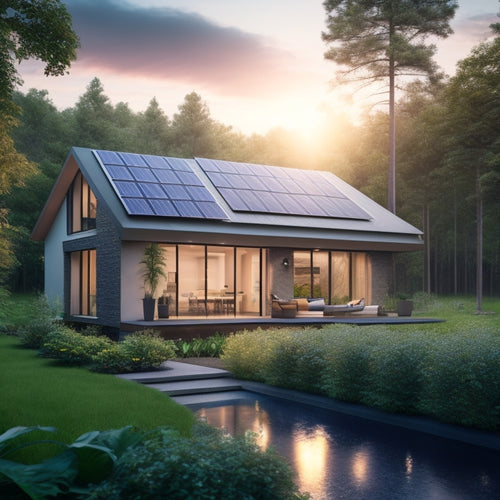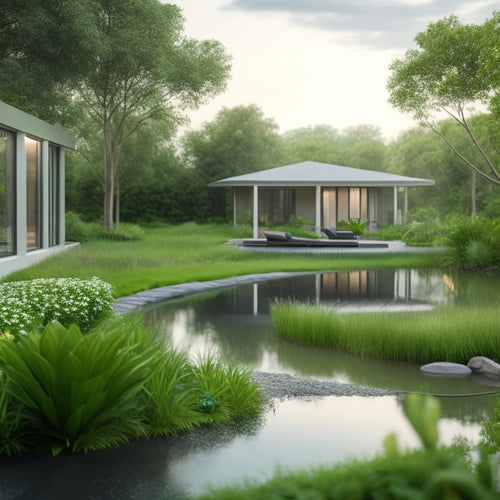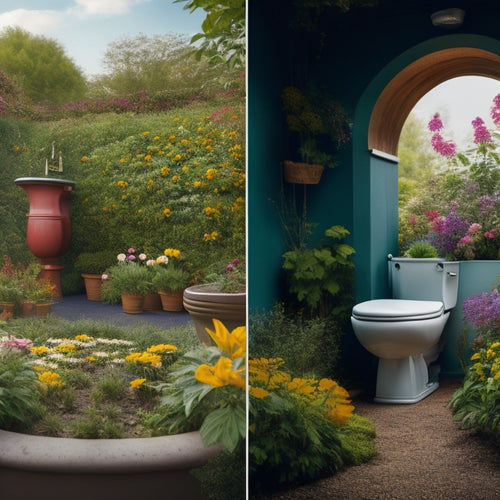7 Tips for Installing Sun-Powered Automated Window Shades
Share
When installing sun-powered automated window shades, you'll need to contemplate seven vital factors for a seamless and energy-efficient experience. Start by evaluating window shade compatibility, measuring width and length, and reviewing shade color options. Next, choose the right solar panel by selecting high-efficiency panels, sizing them correctly, and guaranteeing proper mounting. You'll also need to accurately measure window dimensions, select the ideal shade material, and install the solar power unit correctly. Finally, configure automation settings and test the shades to guarantee proper operation. By following these tips, you'll be well on your way to utilizing the power of the sun to control your window shades, and by exploring each of these factors in more detail, you'll reveal the full potential of your new system.
Key Takeaways
- Assess window compatibility by measuring width and length, considering material and style, and ensuring snug fit for effective operation.
- Choose high-efficiency solar panels (>20%) with suitable size, wattage output, and mounting location for optimal energy generation.
- Measure window dimensions accurately, noting obstructions or irregularities, to ensure precise shade installation.
- Select shade material considering opacity, color, texture, durability, and maintenance requirements for desired light control and aesthetic appeal.
- Ensure proper solar power unit installation, following guidelines for panel placement, tilt angle, and wiring connections for seamless operation.
Assessing Window Shade Compatibility
As you begin the expedition of installing sun-powered automated window shades, an essential first step is to assess the compatibility of these shades with your existing windows.
You'll want to verify the shades fit snugly within the window frame, so measure the width and length of each window to determine the correct size.
Consider the material and style of your windows as well, as some shades are specifically designed for vinyl, aluminum, or wood frames.
When selecting a solar panel for your automated shades, look for high-efficiency options above 20% to maximize energy generation.
Additionally, think about the aesthetic you want to achieve and investigate the various shade color options available.
Choosing the Right Solar Panel
When selecting a solar panel for your automated window shades, you'll need to take into account the panel's size, as it directly impacts the system's energy output.
You'll also need to evaluate the panel's energy output in watt-hours per day, ensuring it can power your shades' motor and battery.
Moreover, you must carefully choose a mounting location that maximizes sunlight exposure while minimizing potential obstructions or shading.
By doing so, you can reduce grid reliance by up to 70% peak shaving, leading to significant cost savings.
In addition, on-site renewable energy generation can contribute to a sustainable future through renewable energy use.
Panel Size Matters
Your solar-powered automated window shades' performance hinges on the correct solar panel size. When selecting a panel, consider the type and its aesthetic appeal. A larger panel may provide more power, but it may not be visually appealing or suitable for smaller windows. Conversely, a smaller panel may not generate sufficient power, but it may be more discreet.
You must strike a balance between performance and aesthetics. Additionally, consider the energy storage systems that will stabilize the power supply and guarantee a reliable energy output.
Measure your window's dimensions and calculate the required power output to determine the ideal panel size. By choosing the right panel size, you'll enjoy peak performance and a seamless user experience.
Energy Output Considerations
Efficient energy harvesting is crucial for powering your automated window shades, and the solar panel's energy output plays a significant role in this process. When choosing the right solar panel, you'll want to evaluate the energy output to guarantee peak shade performance optimization.
Look for solar panels with high solar energy efficiency ratings, typically above 20%. This will assure maximum energy harvesting, even on cloudy days. Additionally, assess the panel's wattage output, considering the power requirements of your automated shades. A higher wattage output will provide a buffer against energy losses, assuring your shades operate smoothly and consistently.
As seen in the benefits of solar power for EV charging, renewable energy solutions can greatly reduce greenhouse gas emissions and energy bills. Moreover, solar power can also promote energy independence and security, making it a dependable choice for powering your automated shades.
Mounting Location Importance
A well-oriented solar panel is vital to utilizing sufficient energy for your automated window shades. When choosing a mounting location, consider the panel's angle and direction to maximize sunlight exposure. Aim for a south-facing orientation, as this receives the most direct sunlight throughout the day.
Adjust the mounting height to minimize shading from surrounding objects, ensuring unobstructed sunlight exposure. It's also important to perform a shade analysis to evaluate potential shading impacts on energy output and optimize the panel's layout for efficient energy production.
Additionally, consider local building codes and regulations, as well as the orientation and tilt angles that impact energy production efficiency, which can be optimized based on geographic location and climate.
Measuring Window Dimensions Accurately
The steel tape measure unfurls with a soft clink, its blade extending like a metallic snake as you prepare to capture the precise dimensions of your windows.
When measuring window dimensions accurately, it's crucial to take into account the type of window you're working with. For casement, double-hung, or sliding windows, measure the width at the widest point, and the height from the top of the head jamb to the sill.
For bay or bow windows, measure the width and height of each section, then calculate the total dimensions.
Use advanced measuring techniques, such as recording measurements at multiple points to guarantee accuracy.
Record your measurements carefully, taking note of any obstructions or irregularities that may affect shade installation.
Selecting the Ideal Shade Material
When selecting the ideal shade material for your sun-powered automated window shades, you'll need to take into account the various shade fabric options, each with its own set of benefits and drawbacks.
You'll want to evaluate factors such as opacity, color, and texture to make certain the chosen material aligns with your desired level of light control and aesthetic preferences.
Additionally, you should assess the durability and maintenance requirements of each material to assure your shades remain functional and visually appealing over time.
Shade Fabric Options
You're faced with a multitude of shade fabric options, each boasting unique characteristics that can greatly impact the overall performance of your sun-powered automated window shades. When selecting the ideal shade material, consider factors such as light filtration, fabric patterns, and opacity.
| Fabric Type | Light Filtration | Opacity |
|---|---|---|
| Blackout | 0% | 100% |
| Light Filtering | 30-50% | 50-70% |
| Solar Shades | 5-15% | 30-50% |
| Transparent | 80-100% | 0-20% |
Choose a fabric that balances your need for natural light with your desire for privacy and UV protection. By selecting the right shade fabric, you'll enjoy a more comfortable and energy-efficient living space.
Durability and Maintenance
Your sun-powered automated window shades' performance and longevity largely depend on the durability and maintenance requirements of the shade material you select.
You'll want to choose a material that can withstand harsh weather conditions, ensuring your shades remain functional and efficient. Look for materials with excellent weather resistance, such as polyester or vinyl, which can handle extreme temperatures and humidity.
When it comes to maintenance, consider the cleaning techniques required for your chosen material. Some materials may require gentle dusting, while others can withstand more aggressive cleaning methods.
Installing the Solar Power Unit
One essential component of your sun-powered automated window shades is the solar power unit, which converts sunlight into electrical energy to operate the system.
When installing the solar power unit, you'll need to carefully consider solar panel placement to guarantee maximum energy absorption. Ideally, the solar panel should be installed on a south-facing wall or roof, tilted at an angle between 30 and 40 degrees. Make sure to secure the panel firmly to prevent damage from wind or weather.
Next, focus on making wiring connections between the solar panel, battery, and motor controller. Ascertain all connections are secure, waterproof, and meet local electrical codes.
Properly installing the solar power unit will ensure a reliable and efficient energy source for your automated window shades.
Configuring Automation Settings Properly
The automation controller, a sophisticated device responsible for orchestrating the shades' movements, requires precise configuration to guarantee seamless operation. You'll need to set up automation triggers that respond to various conditions, such as time of day, sunlight intensity, and temperature. Scheduling options allow you to program specific shade movements at specific times, ensuring your home is always comfortable and energy-efficient.
| Automation Trigger | Description |
|---|---|
| Time-based | Trigger shade movements at specific times of day (e.g., opening at sunrise, closing at sunset) |
| Light-based | Trigger shade movements based on sunlight intensity (e.g., closing when direct sunlight is detected) |
| Temperature-based | Trigger shade movements based on room temperature (e.g., closing when temperature exceeds a set threshold) |
| Manual override | Allow manual control of shades using a remote or wall switch |
Testing and Adjusting Shades
Precision calibration is essential to confirm your sun-powered automated window shades operate flawlessly.
Once you've configured your automation settings, it's time to test and adjust your shades. Start by checking the shade alignment, verifying they're properly synchronized and moving smoothly.
If you notice any issues, troubleshoot by reviewing your setup and automation settings. Check for obstacles or misalignments that might be hindering the shades' movement.
Make adjustments as needed, and retest to confirm seamless operation. Remember to test your shades during different times of day and weather conditions to guarantee peak performance.
Frequently Asked Questions
Can I Install Sun-Powered Shades on Casement or Skylight Windows?
You're traversing uncharted territory, charting a course through window types, wondering if sun-powered shades can anchor onto casement or skylight windows. Fortunately, adaptable installation methods and versatile shade materials make it possible to utilize the sun's power on these unique windows.
Are Sun-Powered Shades Suitable for Windows With Multiple Panes?
You'll face installation challenges with sun-powered shades on multi-paned windows, but they can still enhance energy efficiency; consider customizing the shade's design and motor to accommodate the unique pane configuration for ideal performance.
Do Sun-Powered Shades Work During Power Outages or at Night?
As you ponder the darkness, wondering if your sun-powered shades will abandon you, rest assured they won't leave you in the dark - literally; they often come equipped with backup batteries, ensuring energy efficiency and continued functionality during power outages or at night.
Can I Control Multiple Shades With a Single Automation System?
You can seamlessly control multiple shades with a single automation system, leveraging smart home integration for effortless shade control options, and enjoying freedom from manual adjustments, as you effortlessly orchestrate your window treatments with a single intuitive interface.
Are Sun-Powered Shades Compatible With Existing Window Treatments?
You'll want to assess installation considerations, ensuring sun-powered shades integrate seamlessly with existing window treatments, as incompatible systems can hinder performance; research shade compatibility to guarantee a harmonious blend of functionality and freedom.
Related Posts
-

3 Best Eco-Grants for Home Energy Upgrades
You're eligible for various eco-grants that can help you cut down on energy bills and reduce your carbon footprint by...
-

7 Best Automated Sprinklers for Water-Wise Green Homes
You're likely among the 75% of U.S. homeowners who use in-ground sprinkler systems, and coincidentally, you're also c...
-

Why Transform Human Waste Into Garden Gold?
By changing human waste into garden gold, you'll reduce waste management costs, support sustainable agriculture, and ...


